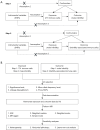Causal role of immune cells in male infertility: a Mendelian randomization study
- PMID: 40376529
- PMCID: PMC12076230
- DOI: 10.21037/tau-2024-657
Causal role of immune cells in male infertility: a Mendelian randomization study
Abstract
Background: Epidemiological studies have shown that early immune inflammatory responses are associated with male infertility, and bacteria and viruses interact with the host's immune and inflammatory systems through their unique structures. This study aims to use Mendelian randomization (MR) to investigate the causal relationship between different immune cell types and the risk of male infertility.
Methods: Male infertility data was obtained from the FinnGen database, and immune cell subtypes data were gathered from the Genome-Wide Association Studies (GWAS) catalog. An MR analysis was performed to investigate the causal relationship between immune cells and male infertility. Several MR methods, including inverse-variance weighted (IVW), weighted median, weighted mode, MR-Egger, and simple mode, were employed. Reverse MR analysis was also conducted to explore the reverse causal relationship. Sensitivity analyses, including Cochran's Q test for heterogeneity, MR-Egger regression for pleiotropy, and MR-PRESSO to exclude pleiotropic outliers, were performed to assess the robustness of the findings.
Results: The study identified 23 immune phenotypes causally associated with male infertility, of which six immune phenotypes were protective, and 17 were risk factors. No reverse causal relationship was found between male infertility and immune phenotypes in the reverse MR analysis.
Conclusions: These results suggest that there is a potential causal relationship between some immune cell subtypes and male infertility at the genetic level.
Keywords: Immune cells; Mendelian randomization (MR); immunophenotype; male infertility; single nucleotide polymorphisms (SNPs).
Copyright © 2025 AME Publishing Company. All rights reserved.
Conflict of interest statement
Conflicts of Interest: All authors have completed the ICMJE uniform disclosure form (available at https://tau.amegroups.com/article/view/10.21037/tau-2024-657/coif). The authors have no conflicts of interest to declare.
Figures



Similar articles
-
A causal relationship between bone mineral density and breast cancer risk: a mendelian randomization study based on east Asian population.BMC Cancer. 2024 Sep 14;24(1):1148. doi: 10.1186/s12885-024-12908-0. BMC Cancer. 2024. PMID: 39277718 Free PMC article.
-
[Genetic Causation Analysis of Hyperandrogenemia Testing Indicators and Preeclampsia].Sichuan Da Xue Xue Bao Yi Xue Ban. 2024 May 20;55(3):566-573. doi: 10.12182/20240560106. Sichuan Da Xue Xue Bao Yi Xue Ban. 2024. PMID: 38948277 Free PMC article. Chinese.
-
Genetic causal relationship between age at menarche and benign oesophageal neoplasia identified by a Mendelian randomization study.Front Endocrinol (Lausanne). 2023 Mar 21;14:1113765. doi: 10.3389/fendo.2023.1113765. eCollection 2023. Front Endocrinol (Lausanne). 2023. PMID: 37025412 Free PMC article.
-
Type 1 diabetes mellitus increases the risk of sudden sensorineural hearing loss: A two-sample Mendelian randomization study.Zhong Nan Da Xue Xue Bao Yi Xue Ban. 2024 Nov 28;49(11):1821-1827. doi: 10.11817/j.issn.1672-7347.2024.240375. Zhong Nan Da Xue Xue Bao Yi Xue Ban. 2024. PMID: 40177765 Free PMC article. Chinese, English.
-
Potential value of B7-H3 in sepsis diagnosis and prognosis: A Mendelian randomization study.Zhong Nan Da Xue Xue Bao Yi Xue Ban. 2024 Nov 28;49(11):1790-1798. doi: 10.11817/j.issn.1672-7347.2024.240139. Zhong Nan Da Xue Xue Bao Yi Xue Ban. 2024. PMID: 40177762 Free PMC article. Chinese, English.
References
LinkOut - more resources
Full Text Sources
